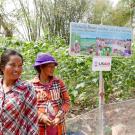Success story: Marketing, postharvest practices help farmers succeed with conservation agriculture
Cambodian farmers reach new buyers with fresh approach
Leaning into her tuktuk in Siem Reap, Eang Chakriya opens a cooler and takes out fresh wax gourds and other vegetables that have been carefully packed and chilled, showing them to a group of neighbors. Emblazoned on the tuktuk (a kind of motorized rickshaw) are images of farmers and the marketing motto, “Grown Right, Handled Right, Community Right.”
Chakriya sells nutritious vegetables directly to consumers in Cambodia as part of a farmers’ cooperative working with the Feed the Future Innovation Lab for Horticulture, led by the University of California, Davis.
The project’s research team is examining incentives that help farmers improve their agriculture practices. The researchers’ hunch is that farmers will adopt conservation agriculture practices (or “Grown Right” practices) if the team also helps them to adopt two other types of profitable practices that will increase their success: improved postharvest handling techniques and novel marketing practices.
So far, the idea seems to be working.
Leading this project, researchers from Kansas State University introduced farmers to conservation agriculture practices: mulch use, diverse crop rotation, and no tillage. Combined with drip irrigation, conservation agriculture can help farmers grow vegetables on small plots with reduced time and labor.
With researchers from Cambodia’s Royal University of Agriculture, the World Vegetable Center and UC Davis, the project team also provided consultation and farmer training in improved postharvest handling — to harvest, sort, pack, transport and store the vegetables to maintain freshness longer. A team from the Horticulture Innovation Lab’s Regional Center at Kasetsart University in Thailand also helped the farmers construct a packing shed to prepare and store their produce, complete with a cold room, evaporative cooler and sorting table.
The cooperative is using marketing techniques that are new in Cambodia to help farmers get the most profit from their crops. For example, farmers connect directly with urban customers, driving their fresh produce into city residential neighborhoods. The produce they sell has been chilled during storage and transit, which helps maintain quality and nutritional content. The farmers also clearly identify the produce as locally grown and emphasize that their crops are an outcome of good environmental practices.
One advantage of these improved practices has been intensified production with more crop rotations per year.
“We’ve increased yields per unit area because of conservation agriculture and the number of times they can plant in the year — from two plantings to up to six plantings per year,” said Manuel Reyes, a Kansas State University research professor who also works with the Feed the Future Innovation Lab for Sustainable Intensification. “Before they finish harvesting, the farmers are already planting the next crop’s seedlings, so they are saving a lot of time overall.”
Confident in their ability to sell high-quality vegetables directly to consumers at higher prices, the cooperative has offered to buy vegetables from its members at a 10 percent premium over other buyers. Today, farmers are enjoying increased incomes from vegetables grown on their conservation agriculture plots, with earnings as high as $1,323 over 10 months.

